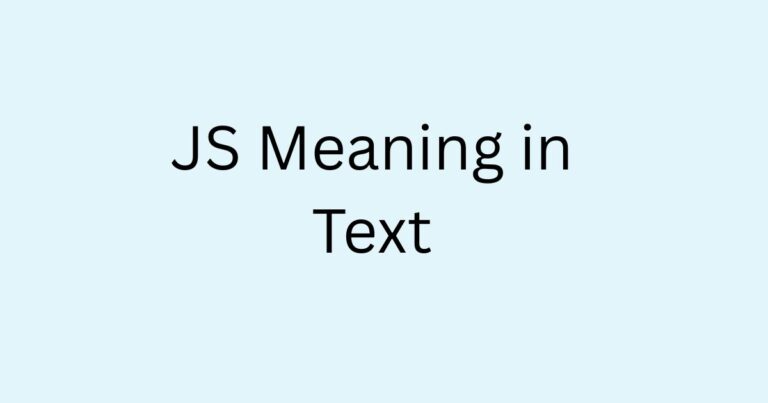I still remember the first time I saw JS in a message—it popped up during a late-night chat with a friend, and I had no idea what it meant. At first, I thought it was some kind of tech lingo related to JavaScript, but soon I learned that in casual digital spaces like texting or social platforms, it’s just another abbreviation. Over time, people have started using JS as a shortened form of “Just Saying,” often slipping it into informal conversations to soften a blunt point or express an opinion without sounding too harsh. You’ll notice it most in communication through media, where phrases are compact and context is everything.
As someone who spends hours crafting online replies, I’ve come to appreciate the nuances of acronyms like JS. It’s not just about the full form, but how you use it. Whether you’re trying to be polite, keep things professional, or sounding casual, knowing when to use “JS” can help you sound more thoughtful and less aggressive. It’s fascinating how one word can shift the tone of a conversation, depending on the setting—be it formal, laid-back, or somewhere between. These little alternatives give us control in text-based interaction, letting us craft our tone carefully in the fast-moving world of social communication.
What Does “JS” Mean in Texting?
If you’ve ever read a message ending in “JS,” chances are the person was trying to soften their opinion or make a blunt observation without sounding too harsh. “JS” simply means “Just Saying” and is often added to express a thought that might otherwise feel a bit strong. In the world of texting, it’s one of those short codes that carry a lot of meaning with just two letters. Depending on the tone and how it’s delivered, it can come off as honest or even slightly passive-aggressive.
I’ve used it myself when I want to give someone a nudge without sounding mean. Like once, I told my roommate, “You’ve worn that same hoodie for a week… JS.” I wasn’t trying to be insulting, just pointing something out with a hint of sarcasm and a bit of honesty. That’s the thing—JS is less about being direct and more about slipping in a side comment that leaves the other person thinking. It’s a clever way to express without confronting.
The Nuance Behind “JS”
The phrase “JS” may be short, but its tone can change completely depending on the context and intent. I’ve noticed how this tiny phrase feels different every time it’s used—sometimes it’s friendly, sometimes sarcastic, or even a bit passive-aggressive. That’s the nuance of it: one moment, it’s casual, and the next, it’s cutting.
In my experience, “JS” can also come off as honest, even blunt, but not always in a bad way. I’ve had conversations where it felt supportive or even constructive, like someone was pointing something out to help rather than judge. Knowing how to interpret it correctly matters a lot, especially when you’re deciding whether to use it yourself. Understanding its tone helps you avoid misunderstandings and makes your messages clearer.
When Should You Use “JS”?
Using JS is usually appropriate in casual conversations, especially when texting your friends or chatting on social media. I often drop it in texts, DMs, or even light-hearted forums and tweets when I want to say something without sounding too serious. It works perfectly in moments where a small comment can say a lot without needing a full explanation.
But when it comes to formal or professional contexts, I’ve learned that it’s better to avoid abbreviations like JS. Instead, I go for full expressions or more thoughtful language to keep things clear and respectful. It makes a big difference when your words match the tone of the setting.
I find JS works best in group chats with friends, comments on social media, or even in casual debates and light observations. It’s also fine in text conversations with peers or family—basically anywhere the vibe is relaxed, and everyone understands you’re just keeping it easygoing.
✅ Polite Alternatives to “JS”
Use these when you’re trying to be kind or gentle in casual or semi-formal conversations:
- Just a thought
- No offense intended
- Not trying to be rude
- Don’t take this the wrong way
- Just being honest
💬 Example: “You might want to double-check your citations… just a thought.”
🧑💼 Professional Alternatives to “JS”
Ideal for work, academic, or client-facing conversations where tone matters:
- For your consideration
- Respectfully suggesting
- I’d like to point out
- Worth mentioning
- FYI
💬 Example: “I noticed a missing benchmark in the report… for your consideration.”
👋 Casual Alternatives to “JS”
Perfect for relaxed, friendly environments like chatting with friends, peers, or family:
- Just throwing it out there
- Not gonna lie
- FYI
- Just being honest
- Joking tone with friendly intent
💬 Example: “Your pasta looked… um… interesting. Not gonna lie 😂.”
How Tone Changes Everything
One of the most important things I’ve learned about texting is that tone can completely change how words sound. A simple phrase like “You talk a lot in meetings. JS.” can come off as cold or even critical, especially without any friendly punctuation or emojis. When I first saw that kind of message, I honestly felt like I was being called out.
But then, compare it to: “You talk a lot in meetings. Just saying 😊” — suddenly the exact same words feel much more friendly. That little emoji and the full phrase really softens the delivery and gives the message a lighter feel. It’s a small difference that changes everything. Now I always think twice about how I use JS, especially when texting people who might take things the wrong way.
15 Top-Tier Ways to Reply to “JS”
Here are some fun, clever, and appropriate ways to reply to someone who ends their texting message with “JS,” depending on the tone, emotion, or expression behind it:
😅 Friendly or Casual Replies
- “Haha fair enough! 😊”
- “Just noticed that, huh? 😄”
- “You’re not wrong 😅”
- “Okay okay, message received!”
- “Appreciate the honesty 👌”
😏 Sarcastic or Witty Comebacks
- “And what’s that supposed to mean? 👀”
- “Bold of you to say that… JS 😏”
- “Coming from you? That’s rich 😆”
- “We throwing shade now?”
- “Oh wow, thanks for the insight 😂”
😬 Defensive or Confused Responses
- “Umm… okay? What are you trying to say?”
- “Not sure how to take that 😬”
- “Wait—are you serious?”
- “Is that a compliment orrr…?”
- “This feels a little harsh, not gonna lie.”
Cultural and Generational Use of “JS”
The use of JS varies widely based on cultural and especially generational habits in digital communication. Here’s how it shifts between groups and why it matters:
🧒 Younger Generations (Gen Z & Millennials)
- Use JS frequently in texting and online conversations.
- Comfortable with slang, abbreviations, and informal tone.
- Often use it in a playful, even sarcastic way.
- Common across social media platforms like TikTok, Instagram, and Twitter.
👴 Older Generations
- May be unfamiliar with what JS stands for.
- Likely to misinterpret it as something more literal or serious.
- Prefer more complete sentences in chat or messages.
- Less exposure to evolving language and internet slang.
When NOT to Use “JS”
Knowing when not to use JS is just as important as knowing when to drop it. In certain settings, it can come off as rude, unclear, or completely inappropriate—even if you don’t mean it that way.
🚫 Avoid “JS” in These Situations:
- Serious conversations where emotions are involved.
- Formal or professional spaces like emails, meetings, or business documents.
- Discussions about sensitive topics (e.g., health, finances, loss).
- When your tone might be misunderstood.
- If your message needs to reflect clarity, respect, and professionalism.
The Power of Clear Communication
When using terms like “JS,” never underestimate the power of clear communication. In fast-paced online or texting spaces, clarity can make all the difference.
✅ Why Clarity Matters
- Helps your message match your intention.
- Avoids being misunderstood due to unclear tone.
- Keeps your expression respectful and thoughtful.
- Supports professionalism in digital settings.
- Makes your interaction more direct and effective.
- Helps avoid confusion, especially in tricky contexts.
Final Thoughts
Wrapping up the discussion on “JS,” it’s clear that this small abbreviation carries a lot of weight in digital communication. Whether in texting or other forms of conversation, it’s all about finding the right balance between casual and respectful.
Read More: Understanding DPMO in the Digital World

JCK Smith is a seasoned writer specializing in the names niche, helping individuals and businesses find the perfect names for groups, teams, brands, and more. With years of experience in creative naming, JCK blends originality with strategic SEO to craft lists that rank high on search engines and provide real value to users.











